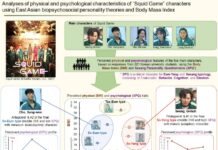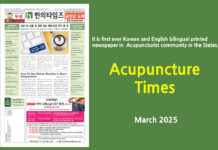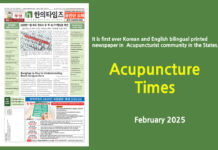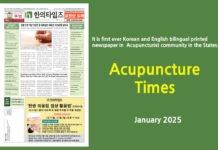For the following case descriptions, it should be pointed out that treatment interventions chosen additionally to the main SaAm strategy are the author’s personal approach: Combining SaAm acupuncture with points selected according to conventional Chinese medicine principles plus moxibustion Korean and Japanese style. The supplemental treatment can greatly vary according to the practitioner’s individual style and preferences. The particular cases were selected to highlight the different modalities of localised channel treatment, zang fu syndrome pattern treatment, treatment according to Six Qi climatic energies and mental-emotional treatment or the overlap of these modalities. This all can be covered using the 24 basic point prescriptions.
Case 1: Female, 29 years, chronic migraine headache.
The patient has been suffering from migraine headache since age 21 with the last three years becoming considerably worse. She has temporal burning pain on the right side with a feeling of her ‘head melting from heat’. The pain is accompanied by nausea and dizziness. Her head feels like wrapped in cotton and dull. The headache gets worse with change of weather especially when the conditions turn wet. When there is not an acute attack of migraine, she suffers from headaches every day continuously. She has little thirst and likes cold drinks. She has hypothyroidism and is extremely adipose. After eating greasy food, she gets diarrhoea. Her facial skin is blemished and oily. Pulse: fast, superficial, thin and slippery with little force in the deep position, thready-full at the Liver/Gall Bladder and Spleen/Stomach position. Tongue: normal coloured body with red spots, very wet (lots of saliva) with a greasy, yellow coating in a stripe along a decent stomach crack, her under-tongue veins are extended.
Diagnosis: Climatic excess of Dampness and Heat according to Six Qi theory.
Treatment: SaAm strategy: Large Intestine jeong gyeok (LI tonification: LI 11 qu chi+, St 35 du bi+, LI 5 yang xi-, SI 5 yang gu-) on the right side. Supplemental points: needling of Sp 9 yin ling quan, LI 4 he gu; EXP tai yang, Liv 3 tai chong, GB 38 yang fu-, hardened muscles of the shoulder-neck area treated with needles and rice corn moxa (e.g. GB 20 feng chi, Bl 10 tian zhu, GB 12 wang gu, trapezius muscle, levator scapulae).
Discussion: This case is an example of the main treatment strategy derived exclusively from Six Qi climatic considerations with other pathophysiological aspects (like zang fu syndrome or channel reference of the pain) left out completely. The patient very clearly has a Damp-Heat constitution according to Six Qi theory with Dampness predominating. She shows this in many signs and symptoms as well as in her tongue and pulse information. However, according to SaAm constitutional ideas the extreme obese physical build alone would be enough to decide on an excess of tai yin (Dampness). Since yang ming Large Intestine energy is the most drying energy of all meridians and additionally has a cooling effect, tonification of Large Intestine is balancing this condition. The supplemental points are chosen to directly address Dampness in her digestive system (Sp 9 yin ling quan), enable the upward and downward movement of clear and turbid fluids and remove internal Wind (LI 4 he gu), move qi stagnation (Liv 3 tai chong), and reduce Heat in the Gall Bladder meridian as concluded from the pulse and location of pain (GB 38 yang fu-).
Case 2: Male, 44 years, allergic rhinitis and allergic asthma.
The condition is persistent since early puberty. The patient is allergic to the hair of cats and dogs. His symptoms after contact with animal hair are dyspnoea, cough and sneezing with little or no sputum. He contracts trivial cold and rhinitis easily and too often which then shows unusual persistent progression. His physical build is moderately overweight, he has always felt warm since early childhood and is seldom freezing in cold weather conditions. Tongue: normal colour but red and thin at the lung area with teeth-marks, also teeth-marks on the sides of the tongue, very little coating. Pulse: fast and thin, weak at Spleen and Lung position. Kidney yin and yang position also deficient.
Diagnosis: Zang fu: Lung yin deficiency with Heat, Spleen qi deficiency, some Kidney deficiency; Six Qi: excess of Heat and Dampness.
Treatment: SaAm strategy: Lung jeong gyeok (Lu tonification: Lu 9 tai yuan+, Sp 3 tai bai+, Lu 10 yu ji-, Ht 8 shao fu-) and Large Intestine jeong gyeok (LI tonification: LI 11 qu chi+, St 36 zu san li+, LI 5 yang xi-, SI 5 yang gu-) on the left body side in Interchange of treatment sessions, with Lung JG preferably at times when more respiratory discomfort is present. Supplemental points: Right side and on the back. Needling: Ki 7 fu liu, Sp 5 shang qiu, St 36 zu san li, Ren 12 zhong wan, EXP ding chuan. Rice corn moxa: LI 4 he gu, LI 11 qu chi, Lu 5 chi ze, Du 12 shen zhu.
Discussion: This case highlights a combination treatment after zang fu syndrome diagnosis and Six Qi climatic aspects. First, the point combination of Lung JG addresses mainly the Lung zang fu deficiency syndrome by tonification and boosting the upright qi of the respiratory system. The alternating tonification of the Large Intestine meridian here has a twofold aspect. The physical build and general feeling of always being warm shows a moderate constitutional excess of Dampness (= overweight) and Heat. Yang ming Large Intestine climatic energy is cooling and drying and thus balancing these factors. Additionally, in SaAm theory yang ming Large Intestine energy is corresponding to the immune system and therefore is often tonified in conditions of weak immune function. Supplemental points: Ki 7 fu li and Sp 5 shang qiu (metal points) are selected to tonify Kidney and Spleen energy with the supposed connection to also influencing the immune system function corresponding to the Metal element. St 36 zu san li and Ren 12 zhong wan strengthen Spleen qi, ding chuan calms dyspnoea and wheezing. LI 4 he gu, LI 11 qu chi and Du 12 shen zhu reduce Wind, regulate the defensive qi and are used in Korean and Japanese moxibustion to boost immune function. Lu 5 chi ze is used as a reactive moxa point for respiratory conditions.
Case 3: Male, 52 years, calcaneal spur.
This patient is standing and walking a lot in his profession. For several months stabbing and burning pain is present in the right heel with a focus spot close to Ki 2 ran gu. Repeated shock wave therapy, heel cushioning and medical insoles showed no effect. In his former profession as an artisan he was working for several years while sitting on his knees a lot in a cold environment, he had kidney stones seven years ago and often has cold hands and feet.
Diagnosis: Weakness of upright qi in the Kidney meridian, from Six Qi perspective the climatic factor of tai yin (cold) is in excess.
Treatment: SaAm strategy: Left side Kidney jeong gyeok (Ki tonification: Ki 7 fu liu+, Lu 8 jing qu+, Ki 3 tai xi-, Sp 3 tai bai-). Supplemental points at the side of pain (right): First needling ah shi points at the heel, in a second step extensive rice corn moxa covering the whole area of pain.
Discussion: This case shows the possibility of a relatively phenomenological approach in SaAm acupuncture disregarding any information from pulse or tongue diagnosis when treating conditions that can be allocated to the local distribution of a meridian. Kidney JG is chosen to strengthen the upright qi of the Kidney channel here solely because of the problem’s location. Such a simple and fast approach of identifying the location of a musculoskeletal problem and then tonifying the related channel (JG) is very often applied in SaAm acupuncture. From a zang fu perspective it might be argued that this patient shows signs of Kidney yang deficiency as well. As already explained, the tonification strategy of jeong gyeok covers all different diagnoses of deficiency. Hence, it is not needed to choose special points for Kidney yin or yang deficiency. From Six Qi perspective his constitution is diagnosed as tai yin (= Cold) excess that can be balanced by using the shao yin Heat of Kidney energy.
Case 4: Male, 57 years, chronic gastritis.
He was sent by his gastroenterologist, because biomedical therapy had no further effect. Three years ago, he was diagnosed with gastritis including massive petechial bleeding in the stomach and oesophagus. His symptoms are bloating, heartburn, abdominal tension, acid regurgitation, stomach pain, loss of appetite and frequent ravenousness.
Proton pump inhibitors and later antiemetic medication were raised over time to the maximum permissible dosage but showed only temporary improvement. The patient often wakes up at night due to stomach pain. With vocational stress his symptoms get worse.
His build is skinny-emaciated and he has lost an additional 4 kgs in the past few months. He is easily freezing with cold hands and feet. He is also suffering from allergic rhinitis and frequent muscular cramps. Tongue: teeth-marks, many transversal and longitudinal cracks, little coating, red and completely peeled in the Stomach area with a large longitudinal Stomach crack. Pulse: full, fast and superficial, weak at the Spleen position, full-wiry pressure at the Stomach and Small Intestine position.
Diagnosis: Zang fu: Spleen qi deficiency, Stomach qi stagnation, Heat and yin deficiency with counterflow of qi, secondary Blood deficiency. Six Qi: Emaciated physical build and lack of tongue coating means an excess of yang ming Dryness, his general tendency to freeze can be understood either as an excess of tai yang Cold or as an stagnation of shao yin Heat stuck in the middle burner not moving to the extremities.
Treatment plan over a course of six months: SaAm strategy: Predominantly Spleen jeong gyeok (Sp tonification: Sp 2 da du+, Ht 8 shao fu+, Sp 1 yin bai-, Liv 1 da dun-), in some sessions Stomach jeong gyeok (St tonification: St 41 jie xi+, SI 5 yang gu+, St 43 xian gu-, GB 41 di wu hui-), in sessions when the patient reported increased stress Pericardium jeong gyeok (PC tonification: P 9 zhong chong+, Liv 1 da dun+, P 3 qu ze-, Ki 10 yin gu-). Supplemental treatment: Needling Sp 4 gong sun, P 6 nei guan, Sp 6 san yin jiao, Liv 3 tai chong; cone moxa on Liv 13 zhang men, Ren 12 zhong wan, Ren 9 shui fen; rice corn moxa on painful, reactive spots of all acupoints in the upper abdomen with palpation of the ren, Kidney, Stomach, Liver and Spleen meridian. This makes up to 10-15 reactive moxa points on the abdomen depending on the present state.
Discussion: This case shows a combined approach of Six Qi constitutional perspective and zang fu syndrome. The use of tonification of Spleen (JG) here has a twofold purpose. First, it addresses problems of Spleen deficiency. Second, according to Six Qi theory increasing tai yin Spleen energy means strengthening the climatic factors of Dampness and Warmth therefore balancing the Dry and somewhat Cold constitution of this patient. The rationale of using the tonification of Stomach JG not so often here is to not increase the Stomach’s yang ming drying climatic energy because of the predominating Dryness. However, as both Spleen and Stomach are Earth element, tonification of their (slight) climatic warmth can cool down the intensive stagnated Heat in the intestines by putting out Fire with Earth and moving stagnation in the middle burner to guide out the general cold (freezing extremities). According to SaAm mental-emotional theory jue yin Pericardium improves feelings of self-assertiveness and competence in relation to issues of skills and knowledge and can be used to reduce symptoms due to professional stress. Also, the Pericardium channel has an inner branch reaching into the stomach to move stagnation in the digestive system with the Pericardium’s climatic moving aspect of Wind. The supplemental acupoints are used to direct counterflow qi downwards (Sp 4 gong sun, P 6 nei guan), tonify Spleen qi and yin (Sp 6 san yin jiao), move Liver qi stagnation (Liv 3 tai chong), furthermore improve Spleen qi and the digestive system (Liv 13 zhang men, Ren 9 shui fen, Ren 12 zhong wan), and remove qi stagnation in the abdominal area with rice corn moxa.
Case 5: Female, 54 years, tinnitus, dizziness, neck pain and hot flushes.
For the last nine months she has suffered from a feeling of pressure wandering up the neck to the temples and top of the head, dizziness, neck pain, occipital headaches, the feeling of pressure behind the eyes, hot flushes and repeated nausea during a situation with a lot of emotional stress. About five weeks ago she started to have tinnitus with a high pitch and a pulsating feeling in her right ear. Consulting with her GP and ENT specialist resulted in no findings. Her orthopaedist thought her condition might be due to some problem in her cervical spine but physiotherapy and osteopathic treatment had no lasting effect. Since about four weeks she also has some sleeping disorders. Abdominal diagnosis shows sensitive, hardened spots at the Korean-style localisation of Liver and Gall Bladder mu-alarm points. Tongue: red on the Heart and Liver area; pulse: fast, thin, weak with both distant pulse positions representing the upper burner comparatively fuller and the pulse position for Kidney yin empty.
Diagnosis: Six Qi: Flaming up of shao yang Ministerial Fire. Zang fu: Liver Yang rising with Liver and Kidney yin deficiency.
Treatment: SaAm strategy: Gall Bladder seung gyeok (GB sedation: GB 38 yang fu-, SI 5 yang gu-, GB 44 zu qiao yin+, LI 1 shang yang-) left side, supplemental points: LI 4 he gu, Sp 6 san yin jiao, Ki 3 tai xi, TH 17 yi feng, SI 19 ting gong, GB 20 feng chi on the right, needling and rice corn moxa on muscular trigger points in the shoulder-neck area.
Discussion: According to Hong-Gyeong Kim’s mental emotional theory excess negative emotions like anger, aggression, frustration, or feeling of lack of power and self-confidence are associated with shao yang Gall Bladder. In Six Qi theory Ministerial Fire is related to the climatic characteristics of shao yang. Emotional disturbance can create an upward flaming of Ministerial Fire which shows in typical signs of alleviated stress like hot flushes, headache, tinnitus, etc. Therefore, many physical symptoms which are understood as Liver yang rising in standard TCM can be interpreted as excess of shao yang Gall Bladder energy from a Six Qi perspective (Gary, 2012). To reduce this excess, Gall Bladder seung gyeok (sedation) is applied here. In SaAm acupuncture this approach is clinically the most often and very effectively applied sedation strategy because of our modern life’s stress and daily hassles. Supplemental treatment is used to improve movement of clear and turbid fluids and remove internal Wind (LI 4 he gu), tonify yin (Ki 3 tai xi, Sp 6 san yin jiao), improve local circulation of the ear (SI 19 ting gong, TH 17 yi feng) and relax the muscles of shoulder and neck.
CONCLUSION
Fruehauf (1999) argues that in modernised TCM aspects of ‘old school’ classical Chinese medicine have been omitted for practical or political reasons, either to adapt it to westernised medical thinking or to cut out some of its many branches in order to make Chinese medicine less complex and fit into the political setting of Mao’s China. It is the author’s opinion the Six Qi might be one of the concepts that has suffered this development, but it has been further developed and has flourished in Korean SaAm acupuncture.
The Six Qi create a more complete understanding of the 12 main meridians and their true meaning. The meridians’ full naming such as Hand yang ming Large Intestine or Foot shao yin Kidney clearly carries the correspondence to their Six Qi climatic characteristics. SaAm acupuncture fully incorporates this often disregarded aspect of meridian energy. The theory of Six Qi is combined with the Five Elements to create a climatic understanding of human physiology. Based on the Six Qi, Hong-Gyeong Kim’s mental-emotional theory offers a framework for the psychological aspects of meridian energy. These approaches add two more layers to the standard modalities of Chinese medicine.
Additionally, the three climatic dimensions of humidity (overweight vs. skinny), temperature (hot vs. cold general sensations) and movement of Wind are utilised for a concise constitutional model. A general excess of any of these qualities can be interpreted as constitutional imbalance. By balancing this excess with the energy of a meridian having opposite climatic quality the body can be supported to heal itself from the present condition. This feature of SaAm acupuncture reflects the main distinguishing character of Korean medicine in comparison to Chinese medicine: To rely more on constitutional factors and focus less on treating specific disease patterns.
Overall, these differences from Chinese medicine at first make it somewhat confusing for the practitioner to consider all possible perspectives for diagnosis and treatment. However, after some clinical practice the systematic approach, the use of only four needles for the main treatment strategy and the constitutional approach provide a useful and fast toolbox to fight our patients` diseases.

































